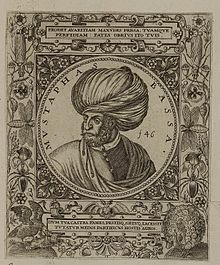| Lala KaraMustafaPasha | |
|---|---|
 Illustration of Lala Mustafa Pasha Illustration of Lala Mustafa Pasha | |
| Grand Vizier of the Ottoman Empire | |
| In office 28 April 1580 – 7 August 1580 | |
| Monarch | Murat III |
| Preceded by | Semiz Ahmed Pasha |
| Succeeded by | Koca Sinan Pasha |
| Personal details | |
| Born | c. 1500 Sokolovići, Sanjak of Bosnia, Ottoman Empire |
| Died | 7 August 1580 (aged 79–80) Constantinople, Ottoman Empire |
| Nationality | Ottoman, Bosniak |
| Spouse |
Hümaşah Sultan (m. 1575) |
| Relations | Sokollu Mehmed Pasha (cousin) Ferhad Pasha Sokolović (cousin or brother) |
| Children | Sultanzade Abdülbaki Bey |
| Occupation | Military strategist and Grand Vizier |
| Military service | |
| Battles/wars | |
Lala Mustafa Pasha (c. 1500 – 7 August 1580), also known by the additional epithet Kara, was an Ottoman Bosnian general and Grand Vizier from the Sanjak of Bosnia.
Life
He was born around 1500, near the Glasinac in Sokolac Plateau in Bosnia to a Christian Sokolović family, the younger brother of Deli Husrev Pasha, who apparently helped him rise through the system's ranks more quickly.
Mustafa Pasha briefly served as kaymakam (acting governor) of Egypt Eyalet in 1549. He had risen to the position of Beylerbeyi of Damascus and then to that of Fifth Vizier.
The honorific "Lala" means "tutor to the Sultan"; he was tutor to Sultan Suleiman the Magnificent's sons, including Şehzade Bayezid. He also had a long-standing feud with his cousin, Sokollu Mehmed Pasha.
He commanded the Ottoman land forces during the conquest of previously Venetian Cyprus in 1570/71, and in the campaign against Georgia and Persia in 1578. During the campaign on Cyprus, Lala Mustafa Pasha, who was known for his cruelty towards vanquished opponents, ordered the Venetian commander of Famagusta, Marco Antonio Bragadin, flayed alive and other Venetian military officers killed on sight or executed, even though he had promised safe passage upon surrendering the city to the Turkish army. It also meant that Mustafa had indicated his aggressive intentions to the Sultan's court.
He was a Damat ("bridegroom") to the Imperial family through his marriage to Hümaşah Sultan, the only daughter of Şehzade Mehmed, son of Suleiman the Magnificent and his wife Hurrem Sultan. The two together had a son named Sultanzade Abdülbaki Bey.
Following his succession of Semiz Ahmed Pasha as Grand Vizier, in the final three months of his life, he occupied the post from 28 April 1580 until his death. He is buried in the courtyard of the Eyüp Sultan Mosque in Istanbul. His tomb was designed by Ottoman architect Mimar Sinan.
Death
Lala Mustafa Pasha died in 1580 in Constantinople due to his old age or a heart attack. He was succeeded by the famous Albanian Koca Sinan Pasha.
Issue
Lala Mustafa Pasha was the second husband of Hümaşah Sultan, Ottoman princess, daughter of Şehzade Mehmed and granddaughter of Sultan Süleyman I and Hürrem Sultan. They married on 25 August 1575. By her, he had a son:
- Sultanzade Abdülbaki Bey. He married Safiye Hanımsultan, daughter of his mother's cousin Ismihan Sultan (daughter of Sultan Selim II and Nurbanu Sultan)
Legacy

He has a street named after him in cities including Larnaca, Cyprus. He has a mosque named after him in Damascus, Syria. His invasion and brutal treatment of the Venetian leaders in Cyprus led to Pope Pius V promoting a Roman Catholic coalition against the Ottomans which turned into the Battle of Lepanto in 1571.
In popular culture
In the 2011–2014 TV series Muhteşem Yüzyıl, he is portrayed by Macit Capodistria.
See also
- Lala Mustafa Pasha's Caucasian campaign
- Ferhad Pasha Sokolović
- List of Ottoman governors of Egypt
- Ottoman Bosnia and Herzegovina
References
- Hamilton Alexander Rosskeen Gibb; Johannes Hendrik Kramers; Bernard Lewis; Charles Pellat; Joseph Schacht (1992). The Encyclopaedia of Islam. Brill. p. 721.
- "Lala Mustafa Paşa kimdir?".
- Kinross, Lord (2002). Ottoman Centuries. Harper Perennial. ISBN 978-0-688-08093-8.
- Abulafia, David (2011). The Great Sea: A Human History of the Mediterranean. Oxford University Press. pp. 449. ISBN 978-0199752638.
- Allahverdi, Reyhan Şahin (2016). An Orphan Sultan: Foundations of Şehzade Mehmed's Daughter Hümasah Sultan. p. 3.
- "SEMİZ AHMED PAŞA". TDV İslâm Ansiklopedisi (in Turkish). Retrieved 14 August 2023.
- Road & Tourist Map of Larnaka. SELAS LTD. ISBN 978-9963-566-92-1.
Sources
- Bicheno, Hugh. Crescent and Cross: the Battle of Lepanto 1571. Phoenix, London, 2003. ISBN 1-84212-753-5.
- Costantini, Vera (2018). "Lala Mustafa Paşa". In Fleet, Kate; Krämer, Gudrun; Matringe, Denis; Nawas, John; Rowson, Everett (eds.). Encyclopaedia of Islam (3rd ed.). Brill Online. ISSN 1873-9830.
- Currey, E. Hamilton, Sea-Wolves of the Mediterranean,, London, 1910
- Foglietta, U. The sieges of Nicosia and Famagusta. London: Waterlow, 1903.
| Political offices | ||
|---|---|---|
| Preceded byDavud Pashaas Governor | Ottoman Governor of Egypt (acting) 1549 |
Succeeded bySemiz Ali Pashaas Governor |
| Preceded byŞemiz Ahmed Pasha | Grand Vizier of the Ottoman Empire 28 April 1580 – 7 August 1580 |
Succeeded byKoca Sinan Pasha |
- 1500s births
- 1580 deaths
- 16th-century Ottoman military personnel
- 16th-century Grand Viziers of the Ottoman Empire
- 16th-century Ottoman governors of Egypt
- Pashas
- Ottoman governors of Damascus
- Ottoman governors of Egypt
- Ottoman people of the Ottoman–Persian Wars
- People from the Ottoman Empire of Bosnian descent
- Bosnian Muslims from the Ottoman Empire
- Devshirme
- Lalas (title)
- Ottoman governors of Cyprus
